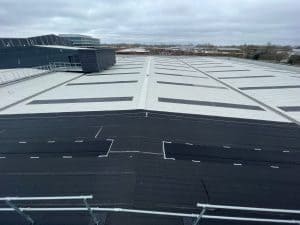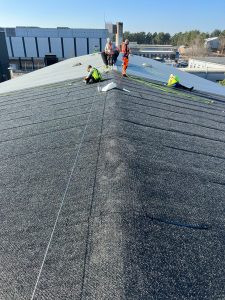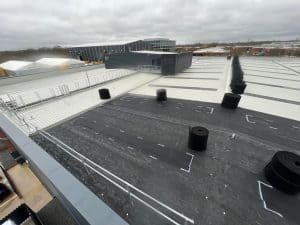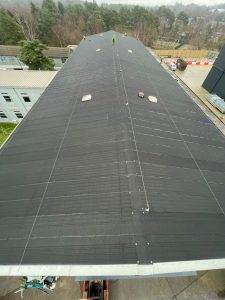
The acoustic insulation question.
Rain noise reaches us as sound waves. During rainfall, various frequencies arise from the impact of raindrops on the roof surface. While the current roof structure may provide some soundproofing, the acoustic insulation question was, most likely, not a priority during construction. When looking to soundproof a roof against rain noise, we often start by adding acoustic attenuation materials that target the specific frequencies raindrops produce.
Resonant Frequency
Any structure vibrates at certain frequencies and roofing panels are no exception, metal or composite, act like a drum skin. Such panels produce sound when raindrops impact them. Thus, addressing the acoustic insulation question and incorporating acoustic treatment materials specifically designed to address this noise issue makes sense.

Adding Mass
Adding mass to the roof is one answer to the acoustic insulation question concerning rain noise reduction. It’s widely recognised that increasing the thickness of roofs or walls can inhibit the propagation of sound waves. Therefore, making the roof thicker and denser seems like a straightforward solution for reducing noise from rain.
The Mass Law
The well-known Mass Law of soundproofing states that doubling the weight of an acoustic barrier yields about a 6 dB improvement in sound reduction. For example, if you double the thickness of a brick wall, you can achieve a 30-40% improvement in soundproofing. This principle also applies to roofs. However, we must consider if the roof can support this additional weight and what the costs might be. But, could we approach this problem from a different angle?

An alternative approach
Adding mass tackles the issue of rain noise after it occurs. Instead, to directly address the acoustic insulation question from a different perspective, we could prevent the rain noise before it is generated. Silent Roof Material (SRM) does just that. This is achieved by installing it on the outside of the roof on top of the existing roof surface. Furthermore, SRM only weighs 800 grams per square meter, allowing most roof structures to easily support this minimal additional loading. So, how does the Silent Roof approach work without adding mass?
How Does It Work
Silent Roof Material (SRM) provides a solution to rain noise by intercepting falling rain drops with its open two dimensionaly structured upper surface. This structure disperses the rain drop which then trickles through the lower three dimensional base of the SRM. As a consequence, the impact noise of the rain drop is dramatically reduced and is not transferred to the roof beneath. The rainwater trickles through the matrix of the SRM and drips softly onto the original roof surface. The rain water then flows into the drainage system. Silent Roof reduces rain noise on any composite roofing structure to a mere whisper. The material is black and UV-stabilised. The flexible properties of SRM enable its use on various surfaces, whether flat or curved. We have developed stable weatherproof methods to secure the material to different surfaces.
Re-Use Potential
Additionally, SRM offers reuse benefits. Since it isn’t bonded to the roof structure, it can also be used to protect temporary structures against rain noise pollution, providing clear advantages to purchasers.

A Technical Description
In Technical Terms
Silent Roof Material (SRM) is a flexible, three-dimensional matting, produced from polyamide monofilaments welded together where they cross to form a tough, open structure. It has a flat back on one side produced from monofilaments in an irregular, two-dimensional structure which is thermally bonded to the three-dimensional structure.

